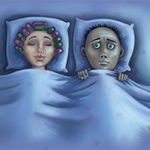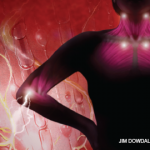Use of MrOS Study Data
Based on self-reported diagnoses and medication use, the 2,562 participants were classified as having either OA (24%) or rheumatoid arthritis (RA) (0.7%). Dr. Lee says she and her research colleagues constructed a composite score of multidimensional sleep health encompassing five dimensions. Those were: perceived sleep quality using self-report, sleepiness using self-report, frequency of daytime napping using actigraphy assessment, amount of waking in the middle of the night using actigraphy, and actigraphy-assessed sleep duration.
The researchers then looked at the serum samples from study participants and used elevated levels of C-reactive protein and interleukin 6 as indicators of inflammation. They controlled for age, smoking status, relevant medication use and comorbidities. They found a significant direct association of RA with elevated C-reactive protein and interleukin 6—not a new finding—but also tested whether that association was mediated by sleep health. It was not. However, men with OA exhibited poorer sleep health than those without OA. Further, poorer sleep health was associated with 16% higher odds of having elevated C-reactive protein. Poorer sleep health was also associated with a 12% higher risk of elevated interleukin 6.
Study Implications

Dr. Lane
Researchers have known for some time the central nervous system is responsive to inflammation and that this affects sleep quality. “We’ve known that OA and pain impact sleep quality and circadian rhythm, but we hadn’t connected this with inflammation,” says study co-author Nancy E. Lane, MD, MACP, distinguished professor of medicine, Center for Musculoskeletal Health/Medicine and Rheumatology at the University of California, Davis, School of Medicine.
Dr. Lee had approached Dr. Lane, a senior member of the MrOS study, to get feedback and pivotal support when the study authors were seeking to classify participants’ arthritis diagnoses. In fact, Dr. Lee notes, one of the study’s limitations is that diagnoses of OA and RA were based on self-report. When Dr. Lane examined the medication lists for these participants, she was able to discern which participants were likely to have RA. In the study sample Dr. Lee was using, 8% of the participants reported they had RA. However, only 0.7% were actually on RA-specific medications, such as disease-modifying anti-rheumatic drugs.
Dr. Lane enjoys mentoring young investigators and notes that she and other MrOS investigators would be open to questions about musculoskeletal diseases in the longitudinal cohort. She invites them to contact her at [email protected], and she can direct the question to the appropriate MrOS investigators.
Based on their study findings, the authors suggest that promoting sleep health in men with OA may help reduce the risk of systemic inflammation. Dr. Lane concurs with this recommendation. “These findings speak to checking on how many times your patients with large joint OA are waking up from pain,” she says. However, if patients are having trouble getting back to sleep, physicians must exercise caution about prescribing sleep medications due to the risk of imbalance and falls.
Dr. Lee is already planning her next sleep study. “Systemic inflammation is a hallmark of chronic disease in late adulthood and arthritis,” she says. “Although we focused on older men in this study, we think that we may be able to replicate the study findings using a sample of older women.”



